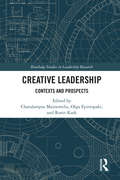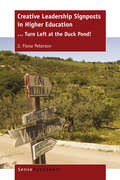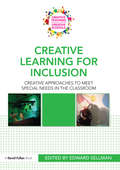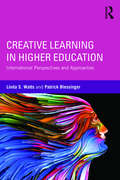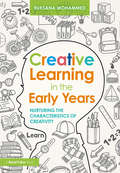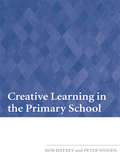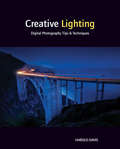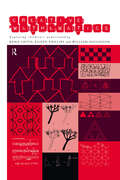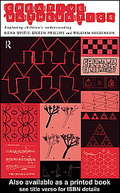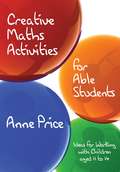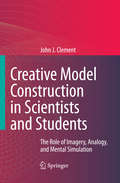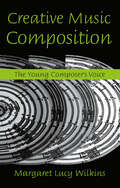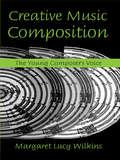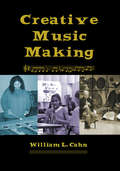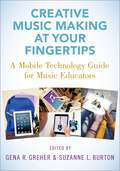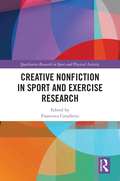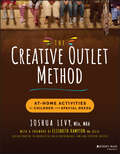- Table View
- List View
Creative Leadership: Contexts and Prospects (Routledge Studies in Leadership Research)
by Charalampos Mainemelis Olga Epitropaki Ronit KarkThere has never been a better time to study, practice, and experience creative leadership. In the fluid and turbulent economic and social environments of the 21st century, creative leadership has become a cardinal force in the creation and evolution of adaptive organizations. In the last two decades, organizational science has witnessed a rapid increase in the number of studies on the nature, skills, and processes of creative leadership. The resulting accumulated body of knowledge has remained for many years dispersed and fragmented across multiple strands of organizational research. This volume seeks to foster the cross-fertilization of scientific knowledge and insight by bringing together authoritative contributions from leading scholars whose work is located in different strands of creative leadership research. Creative Leadership: Contexts and Prospects builds upon a recently introduced multi-context framework that integrates metatheoretically three conceptualizations of creative leadership found in the extant literature: Facilitating employee creativity; Directing the materialization of a leader’s creative vision; and Integrating heterogeneous creative contributions. These three conceptualizations reflect essential differences in the enactment of creative leadership across various collaborative contexts of creative work, and they underlie the intellectual efforts of different research strands. The collection of chapters in Creative Leadership: Contexts and Prospects offers the latest thinking on creative leadership in facilitative, directive, and integrative contexts, and a stimulating set of ideas for crafting the next generation of nuanced theories and empirical studies in the field.
Creative Leadership: Contexts and Prospects (Routledge Studies in Leadership Research)
by Charalampos Mainemelis Olga Epitropaki Ronit KarkThere has never been a better time to study, practice, and experience creative leadership. In the fluid and turbulent economic and social environments of the 21st century, creative leadership has become a cardinal force in the creation and evolution of adaptive organizations. In the last two decades, organizational science has witnessed a rapid increase in the number of studies on the nature, skills, and processes of creative leadership. The resulting accumulated body of knowledge has remained for many years dispersed and fragmented across multiple strands of organizational research. This volume seeks to foster the cross-fertilization of scientific knowledge and insight by bringing together authoritative contributions from leading scholars whose work is located in different strands of creative leadership research. Creative Leadership: Contexts and Prospects builds upon a recently introduced multi-context framework that integrates metatheoretically three conceptualizations of creative leadership found in the extant literature: Facilitating employee creativity; Directing the materialization of a leader’s creative vision; and Integrating heterogeneous creative contributions. These three conceptualizations reflect essential differences in the enactment of creative leadership across various collaborative contexts of creative work, and they underlie the intellectual efforts of different research strands. The collection of chapters in Creative Leadership: Contexts and Prospects offers the latest thinking on creative leadership in facilitative, directive, and integrative contexts, and a stimulating set of ideas for crafting the next generation of nuanced theories and empirical studies in the field.
Creative Leadership Signposts in Higher Education: . . . Turn Left at the Duck Pond!
by Fiona J. Peterson"Creative ways of thinking about leadership are helpful to guide practice and personal growth. This book builds a strategic roadmap for creative leadership practice, putting the spotlight on a leader’s professional development journey in the process. The book is about leadership on the ground in higher education, where the ‘rubber hits the road’. It can also be useful in business, or for anyone wanting to think outside the square. Through a creative storytelling approach, the author takes the reader through Tuscany and her on-the-job experience as a leader of learning and teaching. Along the way, she explains some of the theoretical influences on her thinking and practice – in ways and combinations she hadn’t read about in other leadership books, or experienced in professional development programmes. Through real stories, the author shows how she made creative connections in building her own knowledge on present and past experience, with reflection on how practice can be improved with a clear focus on collegiality and strategic outcomes. This approach reflects the five creative leadership signposts that she explains and illustrates throughout the book. "
Creative Learning for Inclusion: Creative approaches to meet special needs in the classroom (Creative Teaching/Creative Schools)
by Edward SellmanIntroducing creativity to the classroom is a concern for teachers, governments and future employers around the world, and there has been a drive to make experiences at school more exciting, relevant, challenging and dynamic for all young people, ensuring they leave education able to contribute to the global creative economy. Creative Learning to Meet Special Needs shows teachers how to use creativity in the curriculum for key stages 2 and 3 to support the learning of pupils with special educational needs in a way which effectively engages them and leaves a lasting impact on their school experiences and later lives. Describing the different ways in which a creative approach can help pupils with SEN access the curriculum, with activities and practical materials for teachers, this book will explain: why creativity is central to making the curriculum accessible how to use personalised learning with pupils with SEN how to promote achievements and motivation through creative experiences how the curriculum can be extended and represented in innovative ways for pupils with SEN how to use interactive methods of teaching and alternative methods of communication. Providing case studies and examples of the ways in which teachers have delivered the curriculum creatively to pupils with special educational needs, this book is an invaluable guide for all those involved in teaching and engaging young people with special needs.
Creative Learning for Inclusion: Creative approaches to meet special needs in the classroom (Creative Teaching/Creative Schools)
by Edward SellmanIntroducing creativity to the classroom is a concern for teachers, governments and future employers around the world, and there has been a drive to make experiences at school more exciting, relevant, challenging and dynamic for all young people, ensuring they leave education able to contribute to the global creative economy. Creative Learning to Meet Special Needs shows teachers how to use creativity in the curriculum for key stages 2 and 3 to support the learning of pupils with special educational needs in a way which effectively engages them and leaves a lasting impact on their school experiences and later lives. Describing the different ways in which a creative approach can help pupils with SEN access the curriculum, with activities and practical materials for teachers, this book will explain: why creativity is central to making the curriculum accessible how to use personalised learning with pupils with SEN how to promote achievements and motivation through creative experiences how the curriculum can be extended and represented in innovative ways for pupils with SEN how to use interactive methods of teaching and alternative methods of communication. Providing case studies and examples of the ways in which teachers have delivered the curriculum creatively to pupils with special educational needs, this book is an invaluable guide for all those involved in teaching and engaging young people with special needs.
Creative Learning in Higher Education: International Perspectives and Approaches
by Patrick Blessinger Linda S. WattsThis book provides higher education faculty and administrators a scholarly resource on the most salient aspects and emerging trends in creative learning in higher education today. International contributors explore ways to foster creativity in any student, regardless of academic discipline or demographic characteristics and demonstrate that creativity is a skill all students can and should learn. Chapters analyzes how different countries and cultures implement creative learning, exploring issues of instruction, assessment, and ultimately how these practices are transforming learning. This important book helps higher education professionals understand and cultivate creative learning across disciplines in any college and university setting.
Creative Learning in Higher Education: International Perspectives and Approaches
by Patrick Blessinger Linda S. WattsThis book provides higher education faculty and administrators a scholarly resource on the most salient aspects and emerging trends in creative learning in higher education today. International contributors explore ways to foster creativity in any student, regardless of academic discipline or demographic characteristics and demonstrate that creativity is a skill all students can and should learn. Chapters analyzes how different countries and cultures implement creative learning, exploring issues of instruction, assessment, and ultimately how these practices are transforming learning. This important book helps higher education professionals understand and cultivate creative learning across disciplines in any college and university setting.
Creative Learning in the Early Years: Nurturing the Characteristics of Creativity
by Ruksana MohammedTaking a fresh look at the role of creativity within the early years, this accessible guide explores what is meant by creativity and considers how creative skills, behaviours, and thinking can be identified and fostered in the individual child. Underpinned by the latest research and policy, chapters illustrate how creative attitudes can be adopted in all subject areas, and opportunities for creativity maximised. Creative Learning in the Early Years acknowledges the power of creative processes in helping children reach their full potential in the early years and beyond. Photocopiable work tools enable the reader to plan, observe, assess, and record progress as they develop playful and creative approaches, whilst practical advice and demonstrable examples are easily integrated into existing practice. Topics addressed include: recognising and encouraging creative tendencies stimulating the child’s imagination developing adult creativity and self-awareness creating enabling environments and creative spaces using documentation and planning to inspire creativity. An exciting and accessible guide which encourages exploration, experimentation, reflection, and development, Creative Learning in the Early Years will support current and future early years practitioners as they discover the rich opportunities opened by creative practice.
Creative Learning in the Early Years: Nurturing the Characteristics of Creativity
by Ruksana MohammedTaking a fresh look at the role of creativity within the early years, this accessible guide explores what is meant by creativity and considers how creative skills, behaviours, and thinking can be identified and fostered in the individual child. Underpinned by the latest research and policy, chapters illustrate how creative attitudes can be adopted in all subject areas, and opportunities for creativity maximised. Creative Learning in the Early Years acknowledges the power of creative processes in helping children reach their full potential in the early years and beyond. Photocopiable work tools enable the reader to plan, observe, assess, and record progress as they develop playful and creative approaches, whilst practical advice and demonstrable examples are easily integrated into existing practice. Topics addressed include: recognising and encouraging creative tendencies stimulating the child’s imagination developing adult creativity and self-awareness creating enabling environments and creative spaces using documentation and planning to inspire creativity. An exciting and accessible guide which encourages exploration, experimentation, reflection, and development, Creative Learning in the Early Years will support current and future early years practitioners as they discover the rich opportunities opened by creative practice.
Creative Learning in the Primary School
by Bob Jeffrey Peter WoodsCreative Learning in the Primary School uses ethnographic research to consider the main features of creative teaching and learning within the context of contemporary policy reforms. In particular, the authors are interested in the clash between two oppositional discourses - creativity and performativity - and how they are resolved in creative teacher practice. The book complements previous work by these authors on creative teaching by giving more consideration to creative learning. The first section of the book explores the nature of creative teaching and learning by examining four key features: relevance, control, ownership and innovation. The authors devote a chapter to each of these aspects, outlining their properties and illustrating them with a wide range of examples, mainly from recent practice in primary schools. The second section presents some instructive examples of schools promoting creative learning, and how creative primary schools have responded to the policy reforms of recent years. The chapters focus specifically on: how pupils act as a powerful resource for creative learning for each other and for their teachers; how teachers have appropriated the reforms to enhance their creativity; and how one school has moved over a period of ten years from heavy constraint to high creativity. The blend of analysis, case-study material and implications for practice will make this book attractive to primary teachers, school managers, policy makers, teacher educators and researchers.
Creative Learning in the Primary School
by Bob Jeffrey Peter WoodsCreative Learning in the Primary School uses ethnographic research to consider the main features of creative teaching and learning within the context of contemporary policy reforms. In particular, the authors are interested in the clash between two oppositional discourses - creativity and performativity - and how they are resolved in creative teacher practice. The book complements previous work by these authors on creative teaching by giving more consideration to creative learning. The first section of the book explores the nature of creative teaching and learning by examining four key features: relevance, control, ownership and innovation. The authors devote a chapter to each of these aspects, outlining their properties and illustrating them with a wide range of examples, mainly from recent practice in primary schools. The second section presents some instructive examples of schools promoting creative learning, and how creative primary schools have responded to the policy reforms of recent years. The chapters focus specifically on: how pupils act as a powerful resource for creative learning for each other and for their teachers; how teachers have appropriated the reforms to enhance their creativity; and how one school has moved over a period of ten years from heavy constraint to high creativity. The blend of analysis, case-study material and implications for practice will make this book attractive to primary teachers, school managers, policy makers, teacher educators and researchers.
Creative Lighting: Digital Photography Tips and Techniques
by Harold DavisHow to make digital photography lighting more creative—and less challenging! How do you master the art of lighting your photographs? Go beyond the basics, go beyond the "rules," and get creative with the help of renowned photographer Harold Davis. In this book, Harold shows you how to break the boundaries of conventional wisdom and create unique, lively, and beautifully lit photographs. Packed with tips and tricks as well as stunning examples of the author’s creativity, this book will both inform and inspire you to create your own lighting style. Teaches you when and how to control the light in your photographs Reviews the basic “rules” of digital photography lighting and shows you how to break the rules to create your own uniquely lit images Helps you start building a lighting style of your own Includes stunning examples of the author’s photography and lighting techniques Whether you're a beginner or a seasoned digital photographer, you'll find ideas and techniques to spark your creativity.
Creative Lighting: Digital Photography Tips and Techniques
by Harold DavisHow to make digital photography lighting more creative—and less challenging! How do you master the art of lighting your photographs? Go beyond the basics, go beyond the "rules," and get creative with the help of renowned photographer Harold Davis. In this book, Harold shows you how to break the boundaries of conventional wisdom and create unique, lively, and beautifully lit photographs. Packed with tips and tricks as well as stunning examples of the author’s creativity, this book will both inform and inspire you to create your own lighting style. Teaches you when and how to control the light in your photographs Reviews the basic “rules” of digital photography lighting and shows you how to break the rules to create your own uniquely lit images Helps you start building a lighting style of your own Includes stunning examples of the author’s photography and lighting techniques Whether you're a beginner or a seasoned digital photographer, you'll find ideas and techniques to spark your creativity.
Creative Mathematics
by William Higginson Eileen Phillips Rena UpitisThis book shows how creative maths can really work. Exploring the ways in which maths skills can be learned through cross-curricular activities based on visual arts and music, the book presents maths as a meaningful and exciting subject which holds no fears for children. The authors recognise that while maths-phobia prevails in our increasingly mathematicised world, attitudes and approaches to teaching the subject need to be reviewed, and issues such as gender stereotyping, which encourage maths-apathy, need to be tackled at an early stage. Within this collection of classroom-based stories are detailed examples of integrative mathematic projects; these will give teachers the confidence to try out cross-curricular activities in their classes. The book also provides support with difficult areas such as assessment, planning and development. Fascinating to read in its own right this book will appeal to the specialist and non-specialist alike.
Creative Mathematics
by William Higginson Eileen Phillips Rena UpitisThis book shows how creative maths can really work. Exploring the ways in which maths skills can be learned through cross-curricular activities based on visual arts and music, the book presents maths as a meaningful and exciting subject which holds no fears for children. The authors recognise that while maths-phobia prevails in our increasingly mathematicised world, attitudes and approaches to teaching the subject need to be reviewed, and issues such as gender stereotyping, which encourage maths-apathy, need to be tackled at an early stage. Within this collection of classroom-based stories are detailed examples of integrative mathematic projects; these will give teachers the confidence to try out cross-curricular activities in their classes. The book also provides support with difficult areas such as assessment, planning and development. Fascinating to read in its own right this book will appeal to the specialist and non-specialist alike.
Creative Maths Activities for Able Students: Ideas for Working with Children Aged 11 to 14
by Anne Price'All the ideas look easy to use and quick to prepare... This is a very interesting and thought provoking book - it manages to ask questions about how we teach able children but also provides some ideas and some materials to help' - The Association of Teachers of Mathematics Finding stimulating and challenging maths activities for able pupils in a mainstream classroom can be demanding for the busy teacher, especially if maths is not your specialism. Based on her experience as an Advanced Skills Teacher and LEA Consultant, Anne Price explains the issues and theories surrounding the education of able pupils and links these to practical, creative examples to be used in the classroom. Useful resources include: - Photocopiable materials, - Advice on different teaching styles, - Activities and tasks for individuals, groups or the whole class GATCOs, Numeracy Consultants, Learning Support Teachers and Student and class teachers looking for new and creative ways of teaching maths activities to able students will find this book invaluable.
Creative Model Construction in Scientists and Students: The Role of Imagery, Analogy, and Mental Simulation
by John ClementHow do scientists use analogies and other processes to break away from old theories and generate new ones? This book documents such methods through the analysis of video tapes of scientifically trained experts thinking aloud while working on unfamiliar problems. Some aspects of creative scientific thinking are difficult to explain, such as the power of analogies, and the enigmatic ability to learn from thought experiments. This book is a window on that world.
Creative Music Composition: The Young Composer's Voice
by Margaret Lucy WilkinsCreative Music Composition is designed to be an introductory textbook for music students. "Creative composition"-composing in your own style, rather than in the style of a composer of the past-is embraced by music educators not only for composition students, but for beginning performers and music educators, and is often offered to all music students and non-music majors who wish to enhance their musical creativity. With 25 years of experience teaching fledgling composers, the author tackles the key ingredients that make for successful composition, including: stimulus to the musical imagination; discussion of a variety of current musical languages; analysis of many examples from contemporary scores; technical exercises; suggestions as to how to start a composition; structures; and examinations of works from particular genres. Wilkins covers several musical languages, from folk and popular to serialism; analyses various rhythmic forms; suggests approaches for composing for a variety of instruments, from traditional to electronic ones, as well as for the human voice; addresses the nuts and bolts of score preparation; and offers career advice. For all composition students-and for music students in general-Creative Music Composition offers a clear and concise introduction that will enable them to reach their personal goals.
Creative Music Composition: The Young Composer's Voice
by Margaret Lucy WilkinsCreative Music Composition is designed to be an introductory textbook for music students. "Creative composition"-composing in your own style, rather than in the style of a composer of the past-is embraced by music educators not only for composition students, but for beginning performers and music educators, and is often offered to all music students and non-music majors who wish to enhance their musical creativity. With 25 years of experience teaching fledgling composers, the author tackles the key ingredients that make for successful composition, including: stimulus to the musical imagination; discussion of a variety of current musical languages; analysis of many examples from contemporary scores; technical exercises; suggestions as to how to start a composition; structures; and examinations of works from particular genres. Wilkins covers several musical languages, from folk and popular to serialism; analyses various rhythmic forms; suggests approaches for composing for a variety of instruments, from traditional to electronic ones, as well as for the human voice; addresses the nuts and bolts of score preparation; and offers career advice. For all composition students-and for music students in general-Creative Music Composition offers a clear and concise introduction that will enable them to reach their personal goals.
Creative Music Making
by William L CahnMost musicians focus on learning technique (learning how to play an instrument), rather than on developing an individual, unique voice. Creative Music Making focuses on the creative development of musicians from all levels of experience and in all styles of music. Based on the author's experience leading workshops for performers around the world, the easy-to-follow exercises in this text will enable any musician--from beginner to professional--to improve creativity and self-expression. Creative Music Making will open the ears of all musicians, vocalists or instrumentalists, in classical, popular, or jazz styles, to a world of new possibilities.
Creative Music Making
by William L CahnMost musicians focus on learning technique (learning how to play an instrument), rather than on developing an individual, unique voice. Creative Music Making focuses on the creative development of musicians from all levels of experience and in all styles of music. Based on the author's experience leading workshops for performers around the world, the easy-to-follow exercises in this text will enable any musician--from beginner to professional--to improve creativity and self-expression. Creative Music Making will open the ears of all musicians, vocalists or instrumentalists, in classical, popular, or jazz styles, to a world of new possibilities.
Creative Music Making at Your Fingertips: A Mobile Technology Guide for Music Educators
Students are drawn to mobile technologies such as iPads and smartphones because of the sheer endless possibilities of the digital worlds they hold. But how can their potential for stimulating the imagination be effectively used in the music classroom to support students' development of musical thinking? Countering voices that see digital technologies as a threat to traditional forms of music making and music education, this collection explores the many ways in which hand-held devices can be used to promote student learning and provides teachers with guidance on making them a vital presence in their own classrooms. Creative Music Making at Your Fingertips features 11 chapters by music education scholars and practitioners that provide tried-and-true strategies for using mobile devices in a variety of contexts, from general music education to ensembles and from K-12 to college classrooms. Drawing on their own experiences with bringing mobile devices and different music apps into the classroom, contributors show how these technologies can be turned into tools for teaching performance, improvisation, and composition. Their practical advice on how pedagogy and mobile technologies can be aligned to increase students' creative engagement with music and help them realize their musical potential makes this book an invaluable resource for music educators who want to be at the forefront of pedagogical transformations made possible by 21st-century technologies.
Creative Nonfiction in Sport and Exercise Research (Qualitative Research in Sport and Physical Activity)
by Francesca CavallerioAcademics around the world recognise the effectiveness of storytelling as a way to engage audiences in conversations, raising awareness of issues, and encouraging change. Stories are now seen as the best medium to convey information to diverse audiences. This book explores a novel approach to representing research findings through the adoption of creative nonfictional stories (CNF). At a time when dissemination of scientific research is constantly highlighted as a fundamental aspect for academics, CNF represents an opportunity to effectively communicate science to non-academic audiences through stories. By providing practical examples of how to transform findings into compelling stories rooted in data, following the mantra of showing rather than telling, which characterises CNF, Creative Nonfiction in Sport and Exercise Research helps researchers – qualitative, quantitative, established professors, and students – to turn their research into stories. A unique contribution to the field, this book is the first to show rather than tell – the creative nonfiction mantra – scholars how they can move from their classic realist tales to a more creative, compelling, but still rigorous representation of research findings. The book features chapters written by authors from different sport research backgrounds, who present the findings of a previously published ‘classic’ study rewritten in the form of a story. Reflective chapters focusing on the how-to and the challenges of this creative analytical practice complete the work, to support scholars in developing their creative skills.
Creative Nonfiction in Sport and Exercise Research (Qualitative Research in Sport and Physical Activity)
by Francesca CavallerioAcademics around the world recognise the effectiveness of storytelling as a way to engage audiences in conversations, raising awareness of issues, and encouraging change. Stories are now seen as the best medium to convey information to diverse audiences. This book explores a novel approach to representing research findings through the adoption of creative nonfictional stories (CNF). At a time when dissemination of scientific research is constantly highlighted as a fundamental aspect for academics, CNF represents an opportunity to effectively communicate science to non-academic audiences through stories. By providing practical examples of how to transform findings into compelling stories rooted in data, following the mantra of showing rather than telling, which characterises CNF, Creative Nonfiction in Sport and Exercise Research helps researchers – qualitative, quantitative, established professors, and students – to turn their research into stories. A unique contribution to the field, this book is the first to show rather than tell – the creative nonfiction mantra – scholars how they can move from their classic realist tales to a more creative, compelling, but still rigorous representation of research findings. The book features chapters written by authors from different sport research backgrounds, who present the findings of a previously published ‘classic’ study rewritten in the form of a story. Reflective chapters focusing on the how-to and the challenges of this creative analytical practice complete the work, to support scholars in developing their creative skills.
The Creative Outlet Method: At-Home Activities for Children with Special Needs
by Joshua LevyA practical guide for parents and special educators to help enrich the lives of children with special needs In The Creative Outlet Method Book of Creativity: At-Home Activities for Children with Special Needs, certified special education educator Joshua Levy delivers practical and effective resources for conducting over 30 enriching theater arts and improvisational activities. The included exercises will allow children with disabilities to demonstrate creativity, increase self-confidence, and build social skills. Special needs children will benefit from the innovative approaches included in The Creative Outlet Method and experience creative energy from the comfort of home. The book also offers: Opportunities for children with special needs to achieve their academic, social, and behavioral goals Activities that enrich the lives of special needs students, their parents, and other caregivers A 10-step framework to improving the learning outcomes for children with special needs The Creative Outlet Method Book of Creativity is an indispensable resource for the parents and caregivers of special needs children, special education teachers, administrators, and therapists. It's also a must-read for K-12 general educators looking for ways to better engage with their special needs students.
